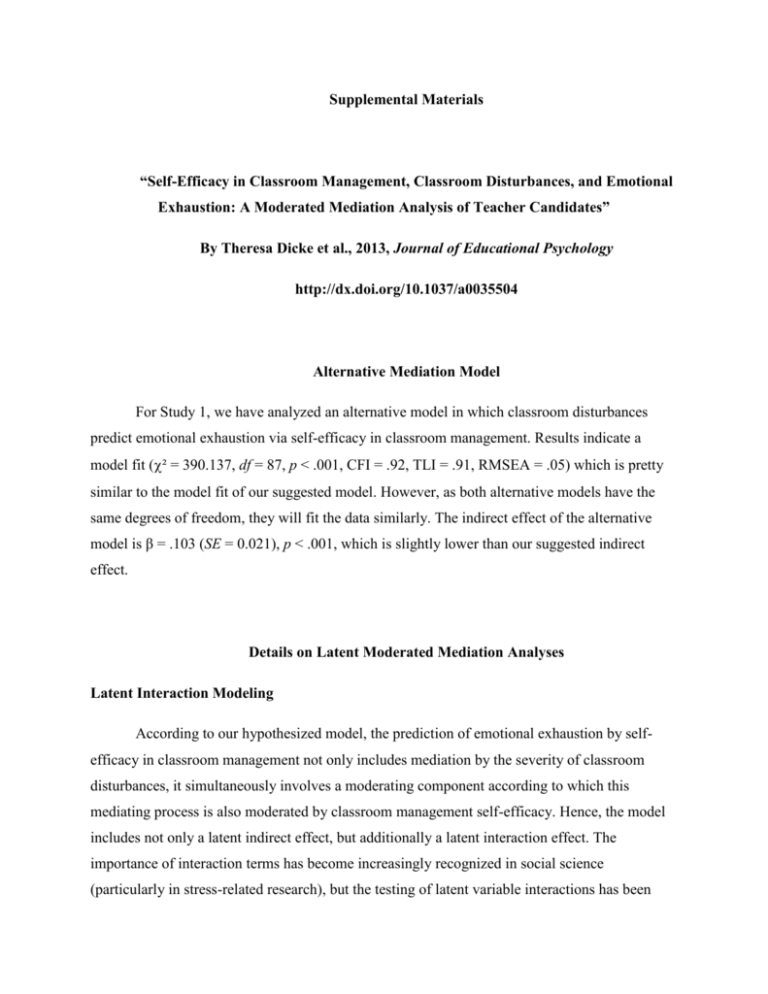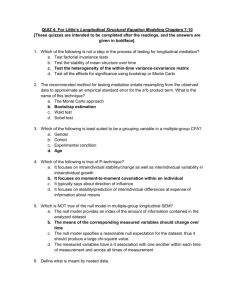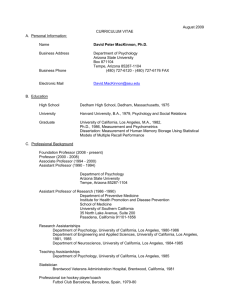EDU-EDU2-Dicke20122241-RR
advertisement

Supplemental Materials “Self-Efficacy in Classroom Management, Classroom Disturbances, and Emotional Exhaustion: A Moderated Mediation Analysis of Teacher Candidates” By Theresa Dicke et al., 2013, Journal of Educational Psychology http://dx.doi.org/10.1037/a0035504 Alternative Mediation Model For Study 1, we have analyzed an alternative model in which classroom disturbances predict emotional exhaustion via self-efficacy in classroom management. Results indicate a model fit (² = 390.137, df = 87, p < .001, CFI = .92, TLI = .91, RMSEA = .05) which is pretty similar to the model fit of our suggested model. However, as both alternative models have the same degrees of freedom, they will fit the data similarly. The indirect effect of the alternative model is β = .103 (SE = 0.021), p < .001, which is slightly lower than our suggested indirect effect. Details on Latent Moderated Mediation Analyses Latent Interaction Modeling According to our hypothesized model, the prediction of emotional exhaustion by selfefficacy in classroom management not only includes mediation by the severity of classroom disturbances, it simultaneously involves a moderating component according to which this mediating process is also moderated by classroom management self-efficacy. Hence, the model includes not only a latent indirect effect, but additionally a latent interaction effect. The importance of interaction terms has become increasingly recognized in social science (particularly in stress-related research), but the testing of latent variable interactions has been hampered by difficulties in estimating interactions that control for measurement error (Marsh, Wen, & Hau, 2004, 2006). This is because interactions between latent variables often require complex procedures for estimating the nonlinear components that make such approaches difficult for applied researchers (Marsh et al., 2006). Recently, however, there have been advances in this respect that have overcome the difficulties of estimating nonlinear components (Marsh et al., 2006). In particular, researchers have advocated the use of unconstrained approaches to latent interactions that are easier to implement and have been shown to produce solutions that are consistent with more complex techniques (Marsh et al., 2004, 2006). Using the unconstrained approach, the observed indicators of interest (self-efficacy in classroom management, classroom disturbances, and emotional exhaustion) were mean-centred and interaction indicators were created by calculating interaction terms between the highest loading items of each scale of interest (loadings obtained from confirmatory factor analysis). Subsequent interaction indicators were developed by multiplying the second highest loading scale items (and so on) until all scale items were accounted for. Due to the different number of indicators in both scales (see Measures section for details), item parcelling was used to create an equal number of item parcels per scale, resulting in three parcels: one containing two items, the other three items each. The item parcels were developed by combining the highest loading items into one parcel, the second highest loading items into another parcel, and the lowest loading items into the remaining parcel in order to meet the needs of the unconstrained approach. These item parcels were then used to estimate a latent interaction factor for use in structural equation modelling. Once the new interaction items were calculated, the latent interaction variable operated in a similar manner to all other latent variables, with the exception that the nonlinear components of the interaction factor were constrained. Power of (Latent) Moderated Mediation Recent studies have investigated the power of mediation models (Fritz & MacKinnon, 2007) or even more complex models (e.g., latent mediation models or models integrating moderation and mediation; Fairchild & MacKinnon, 2009; Morgan-Lopez & MacKinnon, 2006; Thoemmes et al., 2012). Fairchild and MacKinnon (2009) pointed out the difficulties of designs including moderating as well as mediating effects, as these multiply the disadvantages of the already low power of simple interactions and indirect effects due to the small effect sizes observed in real data. Exploring moderated mediation they recommended Ns of up at least 500 for .8 power depending on how well the parameter effect size explains the dependent variable’s variance. Morgan-Lopez and MacKinnon, (2006) who have focused on mediated moderation have found similar results. Fairchild and MacKinnon (2009) also pointed out the lack of research on effect size measures for models that analyze mediation and moderation simultaneously, making it impossible to rely on these as a criterion for meaningful conclusions. However, both of these studies are based on (moderated) mediation of manifest (observed) variables. Thoemmes et al. (2012) took latent mediation models into account and even provided examples for power analysis of partly latent moderated mediation models based on Monte Carlo methods. In these simulation studies, Thoemmes et al. (2012) provided a comprehensible method in which new variables that define the mediated effect in each group and differences in all paths and the product term are initialized. For the moderation of the mediation effect, it is particularly interesting how often the variables tapping the differences reach significance across all iterations of the simulation. However, as this solution indicates, these authors investigated a power analysis of moderated mediation based on a dichotomous moderator (group differences). Moderated mediation based on (possibly more than one) continuous moderator(s) could require a far more complex approach, as calculating simple differences is not possible. Further, following assumptions of Ledgerwood and Shrout (2011), employing all variables as latent variables will most likely influence power as well. Ledgerwood & Shrout (2011) have discussed the possible advantages and disadvantages of manifest versus latent mediation models, including issues of power. They claimed that despite the advantages of latent mediation in terms of bias, it is often countered by a loss in efficiency where the increase in the number of parameters estimated results in greater uncertainty around point estimates (Ledgerwood & Shrout, 2011). Thus, when sample sizes are large, the tradeoff between bias and efficiency is reasonable. However, when sample sizes are smaller, manifest moderated mediation is better due to the greater efficiency. We have taken these assumptions into account by choosing a design consisting of two complementary studies. The first study was based on a large sample size and therefore applied a latent approach, while our second study consisted of a smaller longitudinal subsample of Study 1 and therefore applied a manifest approach. Hence, the combination of these two studies enabled us to boost the advantages and reduce the disadvantages of both approaches. References of Supplemental Materials Fairchild, A. J., & MacKinnon, D. P. (2009). A general model for testing mediation and moderation effects. Prevention Science, 10, 87–99. Fritz, M., & MacKinnon, D. P. (2007). Power to detect the mediated effect. Psychological Science, 18, 233–239. Ledgerwood, A., & Shrout, P. E. (2011). The tradeoff between accuracy and precision in latent variable models of mediation processes. Journal of Personality and Social Psychology, 101, 1174–1188. Marsh, H. W., Wen, Z., & Hau, K.-T. (2004). Structural equation models of latent interactions: Evaluation of alternative estimation strategies and indicator construction. Psychological Methods, 9, 275–300. Marsh, H. W., Wen, Z., & Hau, K.-T. (2006). Structural equation models of latent interaction and quadratic effects. In G. R. Hancock and R. O. Mueller (Eds.), Structural equation modeling: A second course (pp. 225–265). Greenwich, CT: Information Age. Morgan-Lopez A. A, & MacKinnon D. P. (2006). Demonstration and evaluation of a method for assessing mediated moderation. Behavior Research Methods, 38, 77–87. Thoemmes, F., MacKinnon, D. P., & Reiser, M. R., (2010). Power analysis for complex mediational designs using Monte Carlo methods. Structural Equation Modeling: A Multidisciplinary Journal, 17, 510–534.








